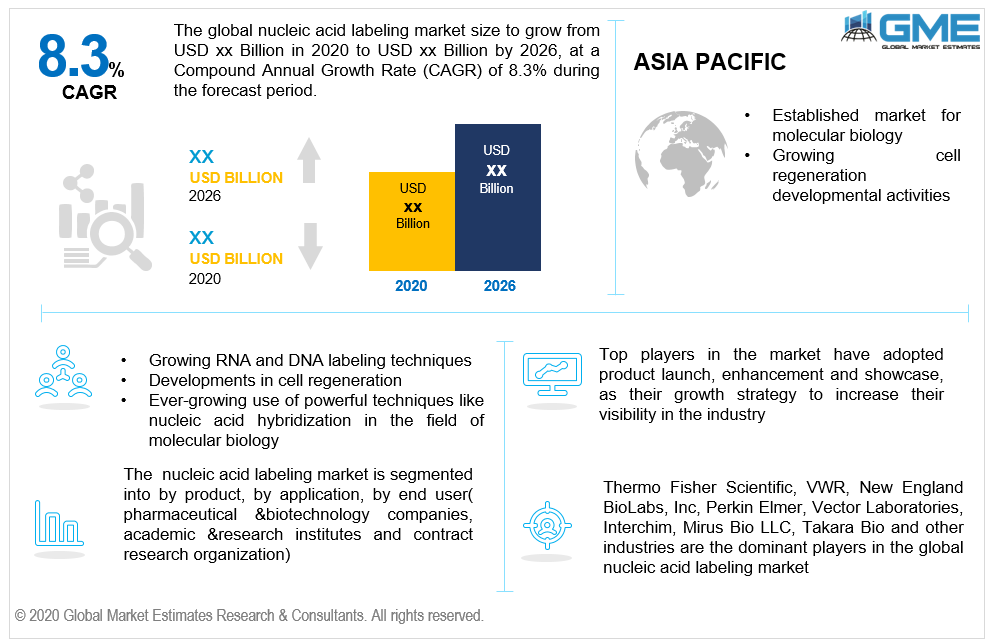
Global Nucleic Acid Labeling Market Size, Trends and Analysis - Forecasts to 2026 By Product (Labels, Probes), By Application (Polymerase Chain Reaction, Fluorescence In Situ Hybridization, Blotting, Microarray, DNA Sequencing, In Situ Hybridization, Others), By End User (Pharmaceutical & Biotechbology Companies, Contract Research Organizations, Academic & Research Institutes), By Region (North America, Asia-Pacific, Middle East and Africa, CSA, Europe), End-User Landscape and Company Market Share Analysis and Competitor Analysis
The nucleic acid labeling market would be growing upwards during the forecast period. Nucleic acids are labeled to allow for purification or detection. Such labeling becomes necessary for studies that elucidate and enhance their functional features in cells and in vitro. The ongoing developments in the pharmaceutical industry across the globe, fast drug approvals in Europe and the USA, and dynamic products offered by the biotechnology companies operating in this market space lead to high market demand in the coming months. RNA and DNA labeling are emerging fields that work to bring researchers and biotechnology companies together which further accentuates the market potential in the biotechnology domain. The breakthrough in the molecular biology field and recent developments in cell structure and regeneration in India positively affect market growth. The ever-growing use of powerful techniques like nucleic acid hybridization in the field of molecular biology allows for the different products of the market to greatly affect the demand in the forecast period. However, the costly assay and dearth of technical staff to perform the testing and labeling can hinder the market demand in the aforementioned period.

The categories of products included in the market are labels and probes. The probes for this market would be the dominating segment as compared to the labels. Given the growing importance of molecular biology in Asian countries, the probe division will enjoy a larger market share. They have been deployed as an important apparatus in the molecular biology field and have been gaining momentum in plant breeding, forensic sciences, diagnosis in medicine, and other fields as new techniques enter the market domain.
The applications studied for this market are DNA sequencing, in situ hybridization, fluorescence in situ hybridization, blotting, and others. The fluorescence in situ hybridization section will have a rising trend in the market owing to varied factors. The method has been used for sequencing and mapping at a large scale all to support the human genome assignments. The medical and biological research deploys the FISH method for higher profits which also makes enhances the market potential for the FISH method. Moreover, the advancing field of digital imaging, fluorescence microscopy, and the presence of bioinformatic and genomic resources leads to high market demand for the FISH segment in the forecast period.
Based on the end-user, the market studies pharmaceutical &biotechnology companies, academic research institutes, and contract research organizations for the nucleic acid labeling field. The pharmaceutical and biotechnology companies would be dominating the market domain owing to wide-scale projects undertaken, extensive R&D activities of the biotechnology companies, and industry-wide reach will enhance the market growth during the forecast period.

Based on the regional study, North America would be a dominant and key region in this market but the Asia Pacific will showcase higher projected growth owing to the established molecular biology field. The developmental activities in the cell structure and regeneration would be leading to a higher market share for nucleic acid labeling. The cell regeneration techniques are also finding application in treating the COVID-19 patients as well.
Key market players operating in the market include Thermo Fisher Scientific, VWR, New England BioLabs, Inc, Perkin Elmer, Vector Laboratories, Interchim, Mirus Bio LLC, and Takara Bio among others.
Please note: This is not an exhaustive list of companies profiled in the report.
In March 2020, the FDA approved the Perkin Elmer to authorize for the testing of COVID-19.
We value your investment and offer free customization with every report to fulfil your exact research needs.
The Global Nucleic Acid Labeling Market has been studied from the year 2017 till 2026. However, the CAGR provided in the report is from the year 2018 to 2026. The research methodology involved three stages: Desk research, Primary research, and Analysis & Output from the entire research process.

The desk research involved a robust background study which meant referring to paid and unpaid databases to understand the market dynamics; mapping contracts from press releases; identifying the key players in the market, studying their product portfolio, competition level, annual reports/SEC filings & investor presentations; and learning the demand and supply side analysis for the Nucleic Acid Labeling Market.

The primary research activity included telephonic conversations with more than 50 tier 1 industry consultants, distributors, and end-use product manufacturers.

Finally, based on the above thorough research process, an in-depth analysis was carried out considering the following aspects: market attractiveness, current & future market trends, market share analysis, SWOT analysis of the companies and customer analytics.

Tailor made solutions just for you
80% of our clients seek made-to-order reports. How do you want us to tailor yours?
OUR CLIENTS